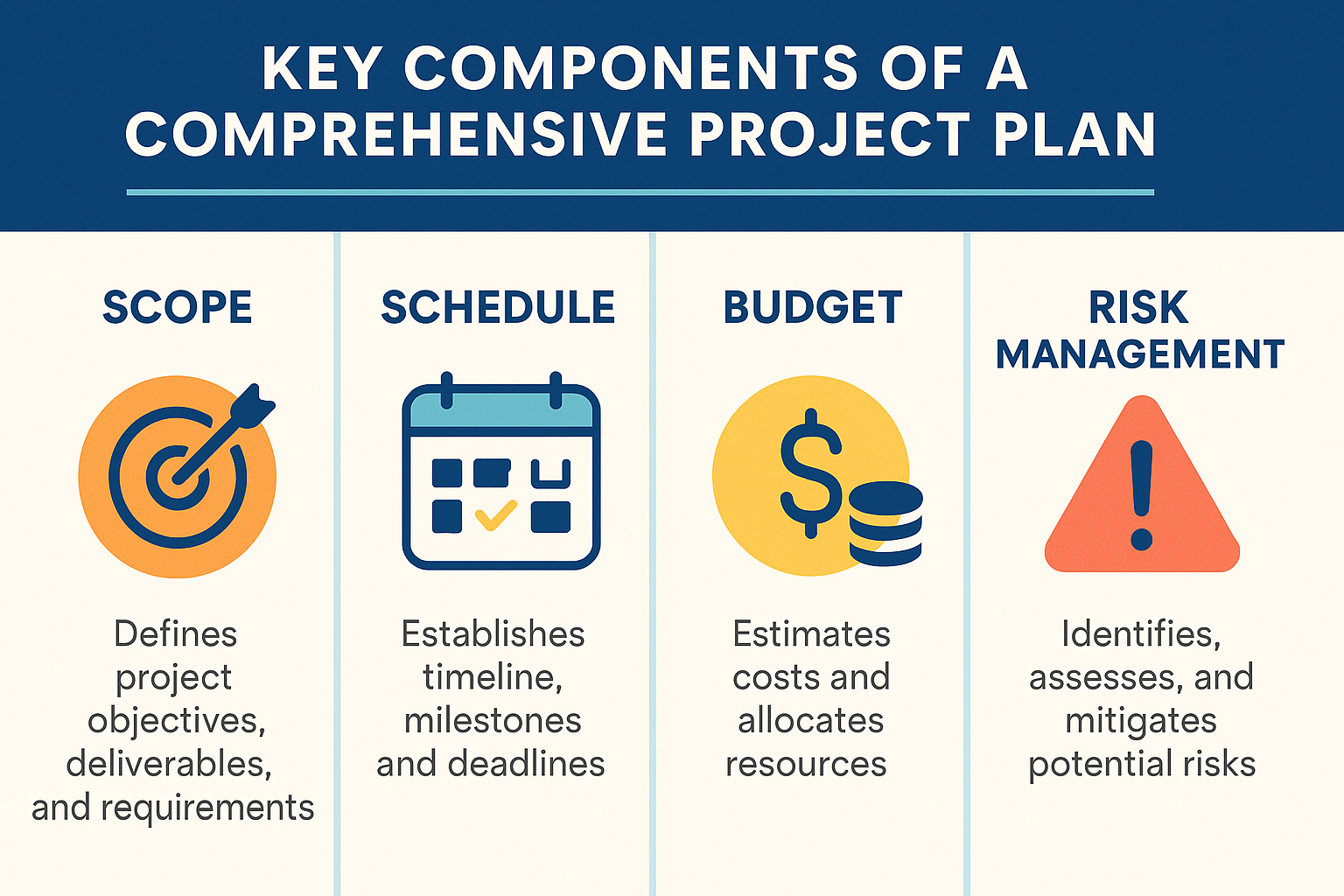Introduction
A project plan is more than just a document — it’s the backbone of successful delivery, keeping teams in sync, stakeholders confident, and projects on track from start to finish. In 2025, where projects move at high speed, teams are often spread across locations, and stakeholders expect instant updates, having a structured plan isn’t optional — it’s essential.
Without a clear project plan, deadlines can slip, budgets can overrun, and priorities can quickly become scattered. With one, you gain a clear roadmap for every phase — from setting objectives to delivering results — so your team knows exactly what to do, when to do it, and how success will be measured.
In this guide, you’ll learn exactly what a project plan is, why it matters, and how to create one step-by-step so you can deliver projects with confidence, no matter the complexity.
What is the Meaning of a Project Plan? Unpacking the Definition
Project planning is the process of defining a project’s goals, scope, timeline, tasks, resources, and execution strategy. It’s where you decide what needs to be done, when it needs to happen, and who is responsible for making it happen.
A solid project plan keeps everyone on the same page — whether it’s the project manager mapping out milestones or team members checking their assigned tasks. By having a clear plan in place, every participant understands their responsibilities, deadlines, and how their work contributes to the overall success of the project.
A well-prepared project plan addresses:
Scope baseline – What’s included (and excluded) in the project.
Schedule baseline – Key dates, timelines, and task sequencing.
Cost baseline – Budget and resource allocation.
Risk management – How potential challenges will be mitigated.
Communication plan – How updates and decisions will be shared.
High-performing organizations successfully complete 89% of their projects, whereas low-performers only complete 36%. – Source
A professional plan is far more than a task list or a schedule. It is a comprehensive set of subsidiary plans that answer the critical business questions:
- What are we building, and why does it matter to the business? (Scope and Objectives)
- Who is accountable, and what are their specific responsibilities? (Team and Stakeholders)
- When will value be delivered? (Schedule and Milestones)
- How much will this investment cost? (Budget and Resources)
- What could derail us, and how are we prepared? (Risks)
At its heart, a great plan is a communication and alignment tool. It is the contract between the project team and the stakeholders, ensuring a shared understanding of success.
The Strategic Importance of a Formal Project Plan
Organizations waste an average of 9.9% of every dollar invested due to poor project performance. – Source
- Creates a Single Source of Truth: It eliminates ambiguity. When a question arises about a deadline, deliverable, or budget, the plan provides the official, approved answer.
- Enhances Stakeholder Management: A formal plan ensures all stakeholders have a shared understanding of goals and constraints from the start, drastically reducing costly misunderstandings later.
- Enables Proactive Risk Management: The planning process forces you to identify and analyze potential threats. A good plan doesn’t just hope for the best; it prepares mitigation strategies in advance.
- Empowers the Project Team: A clear plan provides the autonomy and direction teams need to work effectively, reducing the stress and frustration that comes from chaotic, disorganized projects.
- Provides a Baseline for Performance Measurement: Without a baseline, you’re flying blind. A formal plan gives you the KPIs needed to monitor progress, track variance, and make data-driven decisions.
The Core Components of a Comprehensive Project Plan

- Executive Summary: A brief overview for stakeholders who don’t need the granular details.
- Scope Statement: A clear definition of the project’s boundaries, including what is explicitly in scope and out of scope.
- Success Factors & Objectives: Defines the specific, measurable goals (KPIs) the project must achieve.
- Work Breakdown Structure (WBS): Deconstructs major deliverables into smaller, manageable tasks.
- Schedule and Milestones: The project timeline, often visualized as a Gantt chart, showing durations, dates, milestones, and dependencies.
- Resource Plan & Budget: Details the necessary resources (people, equipment) and their costs. Effective timesheet management is a critical input for tracking actual labor costs against this plan.
- Risk Management Plan: A risk register detailing potential risks, their probability, impact, and the planned response.
- Communication Plan: Outlines how, when, and to whom project information will be communicated.
- Change Management Plan: The formal process for how changes to the plan will be proposed, evaluated, and approved.
How to Write a Successful Project Plan in 7 Steps
Step 1: Define Scope, Objectives, and Success Factors
This is the foundation of your plan.- Identify the Business Problem: A vague goal like “improve the website” is a recipe for failure. A specific goal like “reduce the website’s cart abandonment rate by 10% within Q3” is actionable.
- Set SMART Goals: Ensure your objectives are Specific, Measurable, Achievable, Relevant, and Time-bound.
- Define Key Deliverables: What tangible outputs will the project produce? (e.g., “a final marketing report,” “a working software prototype”).
- Establish Boundaries: Explicitly document what is out of scope to prevent “scope creep.”
Step 2: Identify Stakeholders, Roles, and Responsibilities
A project is a team effort. This step involves identifying everyone involved and defining their role.- Create a Stakeholder Register: List every person, team, or group involved.
- Define Roles with a RACI Chart: For each major task, identify who is Responsible, Accountable, Consulted, and Informed.
Step 3: Create a Work Breakdown Structure (WBS)
Don’t create a schedule from a jumbled to-do list. The WBS is a hierarchical decomposition of the total scope of work.- Start with Major Deliverables: Begin with the high-level deliverables.
- Decompose into Work Packages: Break down each deliverable into smaller components.
- Break Down into Activities/Tasks: Decompose work packages into the specific tasks required. This is the most reliable way to ensure no work is forgotten in your plan.
Step 4: Develop Your Schedule and Timeline
Once you have your WBS, you can build your project schedule.- Estimate Task Durations: For each task, estimate how long it will take.
- Sequence Tasks and Define Dependencies: Determine the logical order of the tasks.
- Identify the Critical Path: Using the critical path method is a professional technique to identify the longest sequence of dependent tasks that determines the project’s minimum duration.
- Visualize with a Gantt Chart: A Gantt chart is the classic tool for visualizing your project schedule. You can also use an S Curve in project management to visualize cumulative progress against this planned timeline.
Step 5: Allocate Resources and Build Your Budget
This step connects your schedule to your people and your money.- Assign Resources to Tasks: Assign your team members to the tasks you’ve defined.
- Perform Resource Leveling: Assess each team member’s workload. This is especially critical when you need to manage multiple projects with a shared resource pool.
- Create a Detailed Budget: Calculate labor costs, materials, software, vendor fees, and contingency funds. The budget in your plan must be realistic.
Step 6: Plan for Risks and Communication
A plan that assumes everything will go perfectly is not a good plan.- Create a Risk Register: Brainstorm potential risks, assess their likelihood and impact, and create a response plan.
- Build a Communication Plan: Define your communication rhythm. Who needs a weekly status report? Who needs to be in the daily check-in? What is the escalation path for problems?
Step 7: Get Approval, Share, and Kick-off
The final step is to formalize and launch your plan.- Consolidate and Review: Gather all components into a single, formal document.
- Seek Formal Sign-Off: Present your completed plan to your project sponsor for formal approval. This document now becomes the official baseline.
- Hold a Kick-Off Meeting: Schedule a formal kick-off meeting with the entire team and key stakeholders to ensure everyone is aligned.
A Deeper Dive into Project Planning Tools & Techniques
- Gantt Charts: The go-to tool for scheduling. Gantt charts excel at visualizing the project timeline, task dependencies, and the critical path, providing a clear picture of who is doing what, and when.
- PERT Charts: A PERT (Program Evaluation and Review Technique) chart is a flowchart used to analyze task dependencies. It’s particularly useful in complex projects for identifying the critical path and understanding how delays in one area will impact others.
- Critical Path Method (CPM): This is a technique, not just a chart. Used with Gantt or PERT, it mathematically identifies the longest sequence of essential tasks. This path has zero “float” or “slack,” meaning any delay on it directly delays the entire project. Mastering this is a key skill for any professional managing a complex plan.
- Work Breakdown Structure (WBS): As mentioned in the steps, the WBS is the foundational tool. A robust plan is impossible without a well-constructed WBS, as it ensures the entire scope is captured before scheduling and budgeting begin.
Adapting Your Project Plan for Different Methodologies
- The Traditional Plan (Waterfall): The detailed, upfront plan we’ve mostly discussed. It is perfect for projects with fixed, stable requirements where all work can be defined before execution begins, such as in construction or manufacturing.
- The Agile Plan (Release Plan / Roadmap): For agile project management, the “plan” is not a static, end-to-end Gantt chart. The plan in this context is a high-level product roadmap that outlines major features or goals over several iterations (sprints). The detailed planning happens just-in-time, at the start of each sprint.
- The Kanban Plan (A Focus on Flow): For Kanban teams, the plan is the board itself, along with a set of policies for managing the flow of work (like Work-in-Progress limits). The goal is not to plan tasks months in advance but to continuously and efficiently pull the next highest-priority item through the system.
How to Present Your Project Plan to Get Stakeholder Buy-In
- Know Your Audience: You present differently to your team than you do to an executive. Executives need the high-level summary, the ROI, the major risks, and the budget. The team needs detailed task assignments and schedule. Tailor your presentation.
- Focus on the “Why,” Not Just the “What”: Start by grounding your presentation in business value. Remind stakeholders of the problem the project is solving and how your plan is designed to achieve that value.
- Lead with the Executive Summary: Provide the key takeaways—timeline, budget, major milestones—upfront.
- Be Prepared to Defend Your Estimates: Show how you arrived at your timeline and budget. This builds credibility and shows your plan is based on analysis, not guesswork.
- Clearly State Risks and Mitigation Plans: Presenting risks doesn’t show weakness; it shows you are a competent and proactive manager who has created a resilient plan.
- End with a Clear “Ask”: Be explicit about what you need—formal approval of the scope, budget, and timeline to establish the project baseline.
Common Project Plan Mistakes to Avoid (And How to Fix Them)
- Mistake 1: Vague Goals & Scope Creep. A plan with a fuzzy objective is doomed.
- How to Fix: Insist on SMART goals (Specific, Measurable, Achievable, Relevant, Time-bound). Implement a formal change control process, so any new request is formally assessed for its impact on your plan.
- Mistake 2: Ignoring Your Stakeholders. A plan created in a silo will fail.
- How to Fix: Create a Communication Plan and a RACI chart early. Involve stakeholders throughout the planning process to ensure alignment and buy-in.
- Mistake 3: Unrealistic Timelines & Budgets. Overly optimistic plans often lead to setbacks.
- How to Fix: Use data from past projects. Involve your core team in the estimation process. Always include a contingency buffer (e.g., 10-15%) for both the schedule and budget in your plan.
- Mistake 4: Forgetting About Risks. A plan without a risk register is incomplete.
- How to Fix: Make risk brainstorming a mandatory team exercise. Create a Risk Register and make it a living document that is reviewed at weekly team meetings.
Project Plan vs. Project Charter: What’s the Difference?
- The Project Charter is a short, high-level document created during the Initiation phase. It authorizes the project’s existence. It is the “project definition plan.”
- The Project Plan is a much more detailed, comprehensive document created during the Planning phase. It is the tactical roadmap that describes how the vision in the charter will be achieved.
Bringing Your Project Plan to Life with Software
- Build your detailed task list and schedule with dependencies.
- Assign work and monitor team workloads in real-time.
- Track time and expenses against your budget automatically.
- Generate automated status reports to keep stakeholders informed.
Conclusion: Your Blueprint for Success
FAQs
What is the meaning of a project plan?
The meaning of a project plan is to serve as the formal, detailed blueprint for a project. It documents the scope, schedule, budget, and resources, acting as the single source of truth for the entire team and all stakeholders.
What are the 5 steps of the project plan?
How do we write a project plan?
You write a plan by following a structured process: define the scope and goals, break the work into tasks, schedule those tasks with dependencies, assign resources and a budget, plan for risks, and get formal stakeholder approval.
What is in a project plan?
A comprehensive plan contains several key components, including a scope statement, a Work Breakdown Structure (WBS), a detailed schedule (Gantt chart), a budget, a resource plan, a risk register, and a communication plan.
What is the project definition plan?
The “project definition plan” is typically another name for the Project Charter. It’s a high-level document created before the detailed project plan that officially defines and authorizes the project’s existence.



